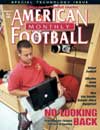Article CategoriesAFM Magazine
|
Stop in the Name of the LawIn NCAA, NAIA, JUCO and High School football, computer use during a game is a huge no-noby: Jane Musgrave © More from this issue When two back-to-back bad calls wiped away Illinois' chances of beating Michigan last fall in the final minutes of a game, the cry went up. "Instant replay," shouted coaches who have long believed that the NCAA should change it's rules to allow referees to review game film on the field if there is any question that they made the right call. To Illinois coach Ron Turner, the issue is a simple one. "The technology is out there these days, so we might as well use it," says Turner, a former assistant with the Chicago Bears. "Why," he asks, should games continue to be decided by bad officiating when the technology exists to make sure that games are won and lost by the players on the field? "They'll say that only a small percent of games are decided by questionable calls," Turner says. "But we only play 11 games a year. If it ....The full article can only be seen by subscribers.
|
|
|||||||
| HOME |
MAGAZINE |
SUBSCRIBE | ONLINE COLUMNISTS | COACHING VIDEOS |
Copyright 2025, AmericanFootballMonthly.com
All Rights Reserved





